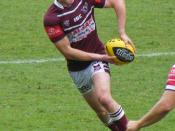There are very few people that can say they've gone through their entire athletic career without ever experiencing defeat. It is only natural to have days and events where you do not perform your best, but what happens when these "temporary losses of form" don't seem to disappear? When an athlete is going through a period of poor performance the media refers to it as a "slump". Each athlete's slump is unique, but they all involve a decline in the expected performance. There has been much debate over the causes and solutions to performance slumps. Where and when they occur is just as puzzling as why they occur. Although difficult to explain, perhaps the best way to combat slumps is to understand them better.
In order to have a better understanding of slumps, it is necessary to define exactly what a slump is. Perhaps the best expression in regards to an athlete experiencing a slump is "having a monkey on your back."
The athlete carries the slump like a weight that cannot seem to be lifted. There are some general characteristics that slumps seem to share. It would appear that slumps are unavoidable in competition overtime (Madden, Summers and Brown, 1990). Also, the cause for the change (deterioration) in performance is unknown/unclear (if it were evident then it could be rectified). Finally, every slump is unique and dependent on the individual athlete (Taylor 1991). A slump is "an unexplained decline in performance from a previously determined baseline level of a particular athlete that extends longer than would be unexpected from normal cyclic variation in performance in a given sport," (Taylor 1988). Now that a workable definition of the term slump has been defined it is possible to address the identification and the cause of performance slumps.
To identify a slump...


